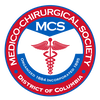The Medico-Chirurgical Society Of The District of Columbia, INC
Information for Physicians and their patients following subjects is available: Diabetes mellitus, Smoking Cesation, HIV/Aids, Childhood Obesity, Asthma, Vitamin D, Osteoporosis in People of Color, Cancer and Disparity Issues.
RACIAL, AGE, AND GENDER DISPARITIES IN THE INDICATIONS FOR TONSIL AND ADENOID SURGERY IN CHILDREN
Earl Harley, MD, FACS
Departments of Otolaryngology and Pediatrics
Georgetown University Hospital
Adedoyin Kalejaiye, MD, Resident, Georgetown University Hospital
Alexis Strohl, MS IV, Student, Georgetown University School of Medicine
Presented at the 2010 National medical Association meeting in Orlando, Florida
Earl Harley, MD, FACS
Departments of Otolaryngology and Pediatrics
Georgetown University Hospital
Adedoyin Kalejaiye, MD, Resident, Georgetown University Hospital
Alexis Strohl, MS IV, Student, Georgetown University School of Medicine
Presented at the 2010 National medical Association meeting in Orlando, Florida
INTRODUCTION
Adenotonsillectomy is one of the most frequently performed operations in children.
The most common indications for adenotonsillectomy can be classified into either obstruction or recurrent infection Obstruction in these cases usually refers to sleep disordered breathing secondary to adenotonsillar hyperplasia and infection refers to recurrent tonsillitis.
Despite how frequently these surgeries are performed, few studies have investigated racial and gender differences in indications for children undergoing adenotonsillectomy
The most common indications for adenotonsillectomy can be classified into either obstruction or recurrent infection Obstruction in these cases usually refers to sleep disordered breathing secondary to adenotonsillar hyperplasia and infection refers to recurrent tonsillitis.
Despite how frequently these surgeries are performed, few studies have investigated racial and gender differences in indications for children undergoing adenotonsillectomy
METHODS
IRB approved retrospective chart review of 1,114 consecutive pediatric patients undergoing tonsillectomy or adenotonsillectomy at Georgetown University Hospital
Data were collected on each patient
Age : 1- 18 grouped in 4 categories; _<2, 3- 5, 6 -12, 13 - 18
Reported Race: Black, White, Hispanic, Other
Indication for surgery: Obstruction, Infection, Obstruction and Infection, Other
Gender: Male, Female
Data were then analyzed in three separate groups: gender, race, and age in relation to indications for surgery
Individual Chi-Square tests performed on the data sets
Logistic regression was used in the statistical analysis Logistic regression
Data were collected on each patient
Age : 1- 18 grouped in 4 categories; _<2, 3- 5, 6 -12, 13 - 18
Reported Race: Black, White, Hispanic, Other
Indication for surgery: Obstruction, Infection, Obstruction and Infection, Other
Gender: Male, Female
Data were then analyzed in three separate groups: gender, race, and age in relation to indications for surgery
Individual Chi-Square tests performed on the data sets
Logistic regression was used in the statistical analysis Logistic regression
RESULTS
There was no significant difference among genders in regards to indications for tonsillectomy/ adenotonsillectomy (p=.133).
Race
There were significant differences in regards to race and indication for surgery. Black children were 4.15 times more likely than whites to have obstruction (CI 2.498-6.884, p=3.81x10-8) and Hispanic children were 4.39 times more likely than whites to have obstruction (CI 1.248-15.472, p=0.021). There was no significant difference among the other races in comparison to white children (p=.582).
Race
There were significant differences in regards to race and indication for surgery. Black children were 4.15 times more likely than whites to have obstruction (CI 2.498-6.884, p=3.81x10-8) and Hispanic children were 4.39 times more likely than whites to have obstruction (CI 1.248-15.472, p=0.021). There was no significant difference among the other races in comparison to white children (p=.582).
Age
When comparing age groups, there were only differences seen when comparing children ages 0-2 to ages 5-12 and 13-18. Children ages 0-2 were 4.364 times more likely than ages 5-12 to have obstruction (CI 1.678-11.353, p=2.53x10-3) and 27.73 times more likely to have obstruction than ages 13-18 (CI 9.187-83.66, p=3.73x10-9)
CONCLUSIONS
The most common indications for adenotonsillectomy is airway obstruction
Black children seem to be disproportionately affected by obstruction which is related to adenotonsillar hyperplasiaYounger children are also more likely than older children to undergo adenotonsillectomy for obstructionFurther studies would do well to investigate the impact of BMI in association with adenotonsillar hypertrophy on sleep disordered breathing.
For more info email: earlharleymd@aol.com
Black children seem to be disproportionately affected by obstruction which is related to adenotonsillar hyperplasiaYounger children are also more likely than older children to undergo adenotonsillectomy for obstructionFurther studies would do well to investigate the impact of BMI in association with adenotonsillar hypertrophy on sleep disordered breathing.
For more info email: earlharleymd@aol.com
